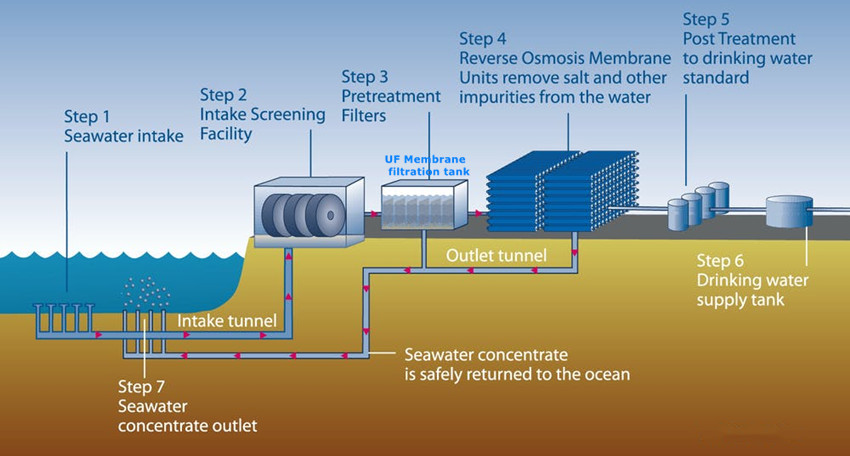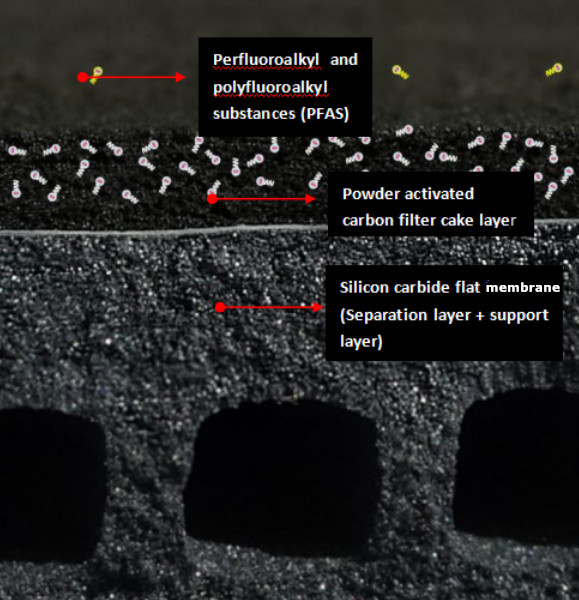Application of Silicon Carbide Ceramic membrane in seawater Desalination Pretreatment
2021-06-29
What is seawater desalination?
Generally, seawater desalination is the removal of salt and impurities from seawater to produce fresh water. It is an open-source technology to realize the utilization of water resources, which can increase the total amount of freshwater without being affected by spacetime and climate, and can ensure a stable water supply for coastal residents and industrial processing. For more knowledge, please visit: https://en.wikipedia.org/wiki/Desalination
In fact, the earth is known as a "water polo", from the 71% of earth surface water, 97.4% is seawater and 2.6% is freshwater, water scarcity around the globe is becoming a significant problem due to the limited availability of freshwater resources and the high cost of transporting fresh water from distant sources to water demand areas. Seawater desalination is indeed a good way to ease the shortage of water sources and plays an important role in solving the freshwater crisis. At present, reverse osmosis seawater desalination (SWRO) technology has become the most important seawater desalination method.

The purpose of seawater desalination pretreatment.
Pretreatment is essential to the whole desalination process and crucial to the success of any desalination project. The purpose of seawater pretreatment is to remove particles, colloids, microorganisms, and other impurities in seawater, so that pretreated seawater quality can meet the influent quality requirements of RO membrane elements, and ensure the long term stable operation of the RO system.
Main methods of seawater desalination pretreatment
1. Conventional pretreatment methods.
Conventional pretreatment has been applied in seawater desalination projects from many decades due to its simple handling methods. It is a traditional pretreatment for RO/NF that consists of several processes such as coagulation, sedimentation, clarification, filtration, softening, disinfection, and so on. It is frequently used for pretreatment to lower the silt density index (SDI) and helps to remove turbidity and suspended solids. Since the separation process is gravity-driven with coarse filtration, conventional pretreatment requires a bigger footprint to install the facilities in a plant. Meanwhile, the system also needs labor operation, a huge amount of chemical is required and difficult to control under variable conditions. Furthermore, it would be easily affected by water temperature, PH, impurities, concentration, and water conservancy conditions, resulting in poor flocculation effect, poor resistance to impact load, and easily sludge accumulation.
2.New seawater pretreatment methods - Membrane separation technology
It has been noticing that conventional pretreatment could not completely remove the colloids and suspended particles to a desire water quality, as a result, microfiltration and ultrafiltration membrane are introduced as a pretreatment method. Nowadays, using these low-pressure filtration membranes for pretreatment have been widely recognized and accepted by most of desalination plant developers and engineers, especially in middle east countries. Compared to conventional pretreatment, the benefits offered by membrane pretreatment are significant as follows:
l Improved pretreated water quality with lower suspended solids and less biological content, resulting in improved RO operation
l Reduce RO membrane cleaning frequency, cost savings in cleaning chemicals
l Lower RO pressure drops from fouling, energy saving
l Longer RO membrane lifespan
l Increased flux rates in the RO system
l Smaller plant footprint
l Reduced environmental impact due to reduced chemical disposal requirements
Ultrafiltration technology of silicon carbide ceramic membrane
As a microfiltration and ultrafiltration membrane, the inorganic ceramic membrane has been widely used in many fields after many years of development. Silicon carbide ceramic membrane, as the most high-end and new material ceramic membrane product, has become the fastest-growing in the field of membrane. It is also one of the most promising membrane products. The use of silicon carbide ceramic membrane for seawater pretreatment mainly has several advantages:
1. Good thermal stability.
Silicon carbide ceramic membrane is made of pure silicon carbide powder as raw material, produced by recrystallization technology and wrapped in inert gas at a high temperature of 2400 ℃, it can be used for liquid separation at high temperature and high viscosity.
2. Excellent chemical stability.
Resistant to strong acid, strong alkali and biological corrosion, good anti-biological performance, good antibacterial.
3. High permselectivity
Because of the increasing asymmetric pore structure of silicon carbide ceramic membrane, and with excellent filtration performance and high precision micropores of 0.04 micron, sic membrane has high permeation selectivity, which is mostly used in ultrafiltration or microfiltration. it has different separation characteristics for inorganic ions, and different separation operations can be carried out.
4. Resistant to contamination, easy cleaning, and long service life.
Silicon carbide membrane will not produce phase transition in the process of separation, its isoelectric point is near PH3, so its surface can maintain a negative charge, it is easy to clean the contaminants on the membrane surface, reduces the maintenance cost, and the service life can be more than ten years.
Introduction of Dynamic membrane double-effect filtration process
Silicon carbide membrane can be used as ultrafiltration membrane alone, but also it can be combined with ultra-fine activated carbon to complete the whole adsorption-filtration process, which can effectively remove free chlorine and other pollution factors in seawater. Thus, total water purification after adsorption and filtration can be achieved, and the water quality can be further improved after desalination.

Expectation
How to further reduce the manufacturing cost and improve the anti-fouling performance of the membrane so as to prolong the service life of the membrane, at the same time, combining with a more workable seawater pretreatment process to reduce the energy consumption of the whole process, which will be the focus of the search on the application of SiC membrane in seawater desalination.
With the global severe water shortage situation, the only feasible way is to develop membrane seawater desalination and other water treatment technology. The use of SiC ceramic membrane in the pretreatment process of seawater desalination will have a huge market room and good application prospects.

 English
English 中文
中文






